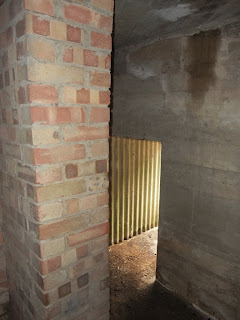A day trip down to Spurn and Kilnsea during the week up in Yorkshire. This post will deal with Kilnsea first (Spurn Point to follow). Second war defences remaining in the Kilnsea area include three lozenge pillboxes, the remains of a coastal battery (9.2 inch guns I think), some massive anti-tank blocks and a defence structure of which I have no idea what it is. It does not seem to be included in the Defence of Britain database. It is basically a large square with wide embrasures (for weapons or observation or both?), a continuous shelf running below the embrasures and three large tables at three of the corners (for mounting a medium machine gun?). There is a large interior chamber in the middle. The roof is interesting as it seems to be constructed in two parts separated by a gap - some 1930's design of pillboxes included air gaps in roofs, the purpose to help absorb the shock of any direct shell blast. I have attached a sketch plan (not to scale) based on memory. I have certainly seen nothing like it before!
Also to be seen nearby is a cold war Royal Observer Corps Post.
Images 1 to 3: Kilnsea Coast Battery (or what's left of it)
Image 4: Lozenge pillbox falling into the sea
Image 5: Unidentified structure - entrance
Image 6 and 7: Unidentified structure - from the outside
Image 8 to 12: Unidentified structure - showing embrasures, continuous shelf and tables
Image 13: Unidentified structure - interior of central chamber
Image 14: Unidentified structure - roof which seems to have been constructed with an air gap
Image 15: Unidentified structure - plan (not to scale)
Image 16: Cold war ROC Post

















































